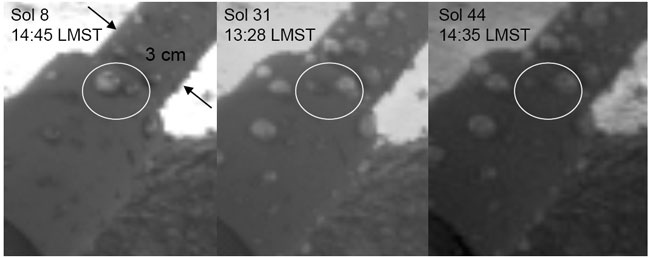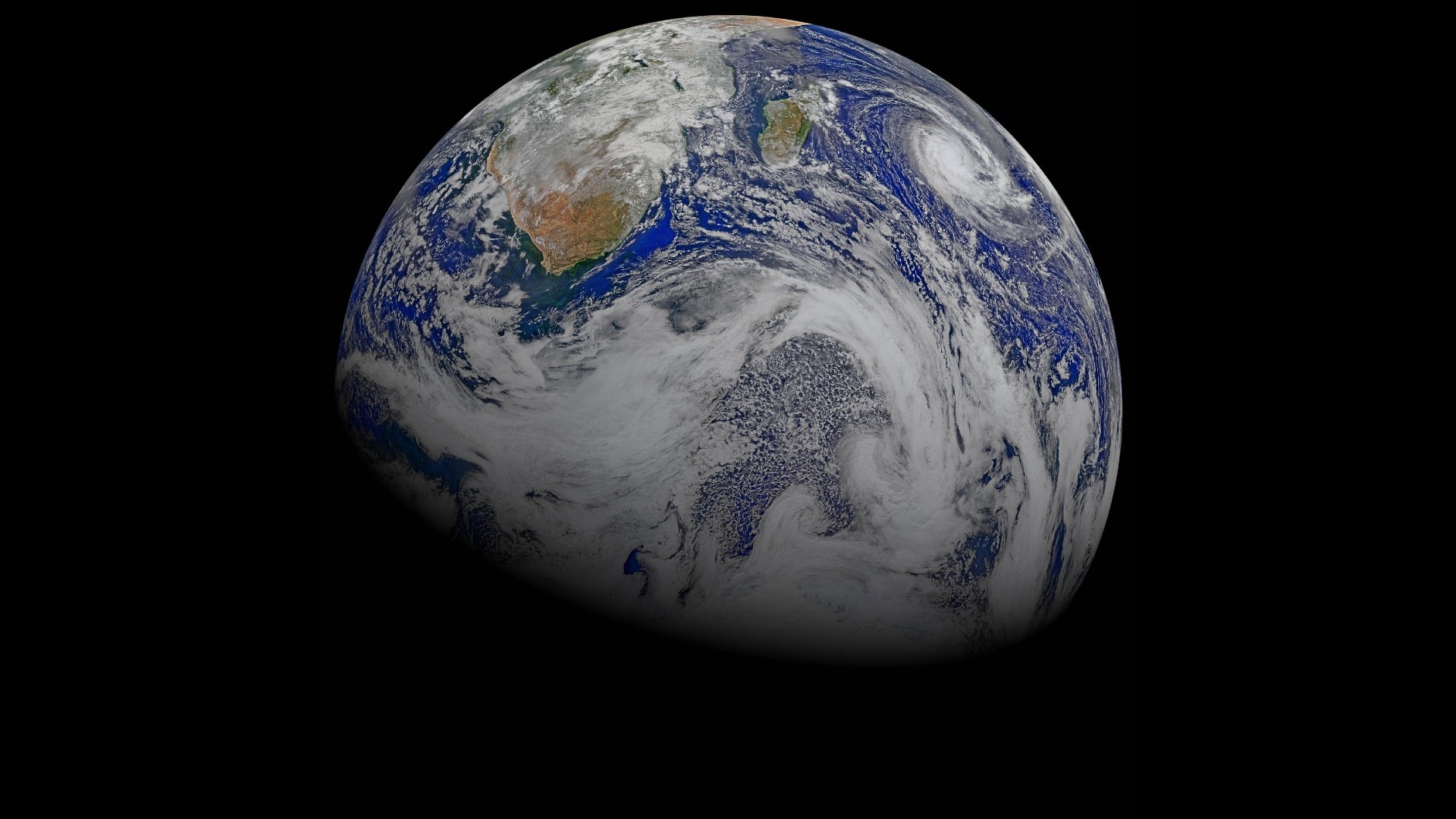Phoenix Mars Lander Found Liquid Water, Some Scientists Think

During itsmore than five-month stint on Mars last year, NASA?s Phoenix Mars Lander foundevidence that liquid water existed at the spacecraft?s landing site, somePhoenix team members say.
Water iskey to all forms of life as we know it and the discovery of liquid water wouldsuggest a greater opportunity for biologyon the red planet.
The new butcontroversial conclusion comes from observations of a set of ?little globules?attached to struts on the lander?s legs that were photographed by Phoenix?s robotic arm camera over the course of the mission, asfirst reported at Spaceflight Now.
These globswere seen to apparently move and grow between snapshots, and 22 members of thePhoenix team, including principal investigator Peter Smith of the University ofArizona in Tucson, think that this behavior combined with other Phoenixfindings indicates that these blobs might have been liquid water that wassplashed up onto the spacecraft as it landed.
The papermaking the case for liquid water will be presented on March 23 at the Lunar andPlanetary Science Conference in Houston. But not all of Phoenix?s team membersagree with the paper?s interpretation of the globs.
?It?s a bitcontroversial,? Smith told SPACE.com. But ?obviously they came fromsomewhere ??? they weren?t there when welaunched,? he added.
Phoenixtouched down at its landing site in the Martian arctic on May 25, 2008. The stationarylander?s mission was to search for signs of potential habitability on the redplanet, namely, signs that water ice just below the surface was once liquid.
Breaking space news, the latest updates on rocket launches, skywatching events and more!
On July 31,2008, Phoenix confirmed that the hard material it encountered underneath theclumpy surface dirt was indeed water ice. Analyses of dirt done in thelander?s onboard instruments also indicated that this ice was likely onceliquid and had interacted with the Martian regolith, or dirt, at a period oftime in Mars? history when its climate was warmer.
But findingliquid water on the present surface of Mars, which sees temperatures between-20 and -80 degrees Celsius (-4 and -112 degrees Fahrenheight) even in thesummer, is a whole different ball game. It was expected that any water iceexposed to the atmosphere would immediately sublimate, or turn to vapor. ThePhoenix team saw signs of this when they exposed underground ice in thetrenches dug by the spacecraft.
The newreport?s main author, Phoenix team member Nilton Renno, proposes that perchlorate salts, discovered in the Martian dirt byPhoenix?s wet chemistry lab, were concentrated enough in a patch at thespacecraft?s landing site that they could lower the freezing point of the waterice, causing it to melt into a salty brine (this is the same phenomenon that causessidewalk salt to melt down snow and ice in the winter).? Nilton and hisco-authors think the brine could have been splashed up onto the lander leg whenPhoenix touched down.
Of course,Phoenix didn?t get any samples of this material and any investigation of theblobs relies on the images taken by Phoenix and knowledge of how perchloratebehaves.
?There?s amatter of belief at some level,? Smith said.
Smithcautions that the case isn?t solved for sure. As Phoenix descended to thesurface, its thrusters created a high-pressure, high-temperature environmentand blasted ammonia which could have affected the surface below it. There couldalso be other constituents in the dirt that could affect its chemistry, hesaid.
But thecase for liquid water is compelling, Smith said. Though he added, ?I can?t sayI agree with every statement in the paper.?
MichaelHecht, the lead scientist for the instrument that discovered perchlorate,thinks that while the idea of this splash of liquid brine isn?t physically impossible,it is ?far less likely than simpler explanations,? he told SPACE.com.
The imagingof the globules is low resolution, which Smith also pointed out, and some ofthe apparent changes seen in them could be attributed to changing shadows,Hecht said.
And whileperchlorate is an excellent sponge, sucking up water if the surrounding air iswarm and dry enough, the temperatures required of the lander mentioned in thepaper are too warm and ?you would not get liquid droplets of perchloratebrine,? Hecht explained.
A morelikely explanation, Hecht contends, is that water vapor released by the groundice stuck to the legs.
The legswould likely be relatively cold compared to the ground during the day, Hechtexplained. When sunlight fell on the patches of ice exposed at the landingsite, some of that water would sublimate. As that water vapor traveled upthrough the air, it might encounter cold patches of dirt stuck on the landerlegs from the landing and stick.
And ?oncethere?s ice there, [other water vapor molecules will] go to the places wherethere?s ice,? eventually forming the blobs seen in the photos, Hecht said.
There arecircumstances where perchlorate could create liquid brine on Mars though, Hechtsaid. During periods when Mars might have just a few degrees warmer,perhclorate rinds could melt water ice. Another paper being presented at theLunar and Planetary Science Conference posits that perchlorates could seep downbeneath Mars? polar ice caps, forming a lubricating sludge that lets the icecaps flow.
But thesesituations are different than the briny blobs described by Renno.
Hechtacknowledges that he could be wrong and the globs on Phoenix could be liquidbrine, but ?I just don?t think it?s the likely explanation,? he said. ?It?sjust plain old frost, nothing more.?
Hechtthinks that the true nature of these blobs will be hashed out over time by thePhoenix team and by reviewers of Renno?s paper. (Hecht and Renno, as well asother Phoenix team members, have corresponded at great length over the topic.)
?It hasn?tbeen in front of the jury yet,? Hecht said.
Editor's Note: The image showing the globules was added at 11:30 a.m. E.T.
- Video: Digging on Mars
- Phoenix Mars Lander: Digging for Secrets of the Martian Arctic
- Images: Phoenix on Mars

Andrea Thompson is an associate editor at Scientific American, where she covers sustainability, energy and the environment. Prior to that, she was a senior writer covering climate science at Climate Central and a reporter and editor at Live Science, where she primarily covered Earth science and the environment. She holds a graduate degree in science health and environmental reporting from New York University, as well as a bachelor of science and and masters of science in atmospheric chemistry from the Georgia Institute of Technology.
